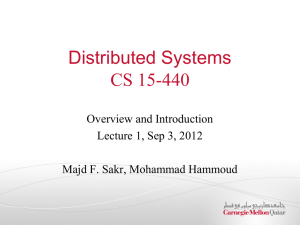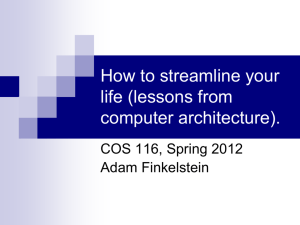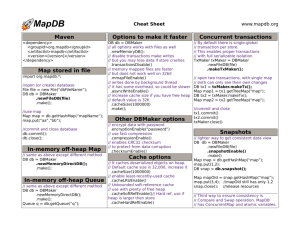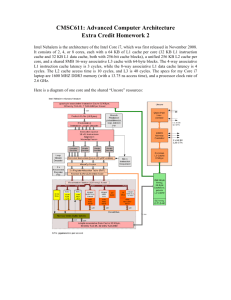Slide 1
advertisement
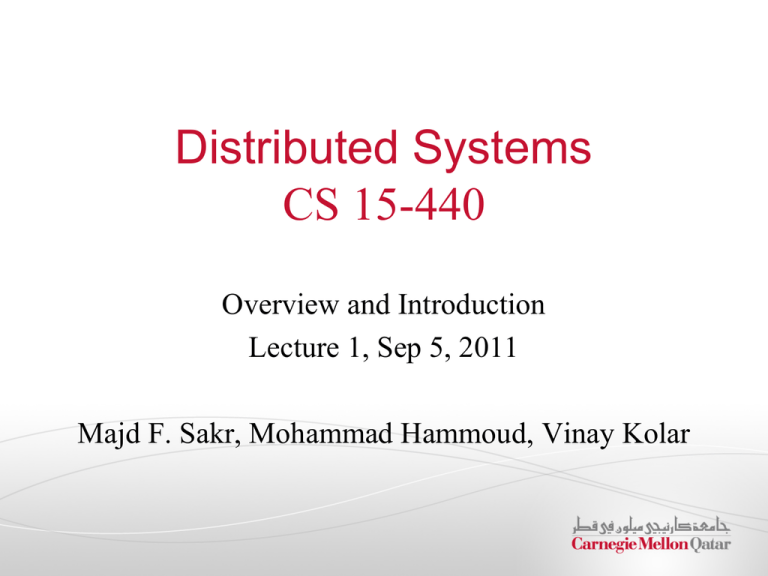
Distributed Systems CS 15-440 Overview and Introduction Lecture 1, Sep 5, 2011 Majd F. Sakr, Mohammad Hammoud, Vinay Kolar Why should you Study Distributed Systems? Application Domain Associated Networked Application Finance and commerce eCommerce e.g. Amazon and eBay, PayPal, online banking and trading The information society Web information and search engines, ebooks, Wikipedia; social networking: Facebook and MySpace. Creative industries and entertainment online gaming, music and film in the home, user-generated content, e.g. YouTube, Flickr Healthcare health informatics, on online patient records, monitoring patients Education e-learning, virtual learning environments; distance learning Transport and logistics GPS in route finding systems, map services: Google Maps, Google Earth Science The Grid as an enabling technology for collaboration between scientists Environmental management sensor technology to monitor earthquakes, floods or tsunamis Definition of a Distributed System A distributed system is: A collection of independent computers that appear to its users as a single coherent system (Tanenbaum book) One in which components located at networked computers communicate and coordinate their actions only by passing messages (Coulouris book) Why Distributed Systems? Scale Processing Data Diversity in Application Domains Collaboration Cost Why Distributed Systems? A. Big data continues to grow: In mid-2010, the information universe carried 1.2 zettabytes and 2020 predictions expect nearly 44 times more at 35 zettabytes coming our way. B. Applications are becoming data-intensive. Why Distributed Systems? C. Individual computers have limited resources compared to scale of current day problems & application domains: 1. Caches and Memory: L1 Cache L2 Cache 16KB- 64KB, 2-4 cycles 512KB- 8MB, 6-15 cycles L3 Cache Main Memory 4MB- 32MB, 30-50 cycles 1GB- 4GB, 300+ cycles Why Distributed Systems? 2. Hard Disk Drive: Limited capacity Limited number of channels Limited bandwidth Why Distributed Systems? 3. Processor: The number of transistors that can be integrated on a single die has continued to grow at Moore’s pace. Chip Multiprocessors (CMPs) are now available P P P P P L1 L1 L1 L1 L1 Interconnect L2 L2 Cache A single Processor Chip A CMP Why Distributed Systems? 3. Processor (cont’d): Up until a few years ago, CPU speed grew at the rate of 55% annually, while the memory speed grew at the rate of only 7% [H & P]. P P P P P L1 L1 L1 L1 L1 Interconnect L2 L2 Cache Memory Memory P M Processor-Memory speed gap Why Distributed Systems? Even if 100s or 1000s of cores are placed on a CMP, it is a challenge to deliver input data to these cores fast enough for processing. P P P P L1 L1 L1 L1 Interconnect A Data Set of 4 TBs L2 Cache 10000 seconds (or 3 hours) to load data Memory 4 100MB/S IO Channels Why Distributed Systems? Splits P L1 A Data Set (data) of 4 TBs 100 Machines P L1 L2 L2 Memory Memory Only 3 minutes to load data Requirements But this requires: A way to express the problem as parallel processes and execute them on different machines (Programming Models and Concurrency). A way for processes on different machines to exchange information (Communication). A way for processes to cooperate, synchronize with one another and agree on shared values (Synchronization). A way to enhance reliability and improve performance (Consistency and Replication). Requirements But this requires (Cont.): A way to recover from partial failures (Fault Tolerance). A way to secure communication and ensure that a process gets only those access rights it is entitled to (Security). A way to extend interfaces so as to mimic the behavior of another system, reduce diversity of platforms, and provide a high degree of portability and flexibility (Virtualization) An Introductory Course on Distributed Systems Considered: a reasonably critical and comprehensive perspective. Thoughtful: Fluent, flexible and efficient perspective. Masterful: a powerful and illuminating perspective. .1. Introduction .2. Processes and Communications .3. Naming .4. Synchronization .5. Consistency and Replication .6. Fault Tolerance .7. Programming Models .8. Distributed File Systems .9. Virtualization .10. Security Intended Learning Outcomes Introduction Processes and Communication Naming Synchronization • ILO0: Outlining the characteristics of distributed systems and the challenges that must be addressed in their design. • ILO1: Explain and contrast the communication mechanisms between processes and systems. • ILO2: Identify why entities and resources in distributed systems should be named, and examine the naming conventions and name-resolution mechanisms • ILO3: Describe and analyze how multiple machines and services should cooperate and synchronize to correctly solve a problem. Intended Learning Outcomes Consistency and Replication Fault Tolerance Programming Models Distributed File Systems • ILO4: Identify how replication of resources improve performance in distributed systems, and explain algorithms to maintain consistent copies of replicas. • ILO5: Explain how a distributed system can be made fault tolerant. • ILO6: Explain and apply the shared memory, the message passing, and the MapReduce programming models and describe the important differences between them. • ILO7: Explain distributed file systems as a paradigm for generalpurpose distributed systems, analyze its various aspects and architectures, and contrast against parallel file systems. Intended Learning Outcomes • ILO8:Explain resource virtualization, how it applies to distributed systems, and how it allows distributed resource Virtualization management and scheduling. Security • ILO9: Explain the various concepts and mechanisms that are generally incorporated in distributed systems to support security. Course Objectives The course aims to provide an understanding in Principles on which distributed systems are based Distributed system architectures Distributed system programming models and algorithms How modern distributed systems meet the demands of contemporary distributed applications Designing and implementing sample distributed systems Teaching Team Majd F. Sakr (MFS) MFS Vinay Kolar (VKO) Office Hours • Tuesday, 3:00- 4:00PM. • Welcome when his office door is open. • By appointment. VKO Office Hours • Sunday, 1:30- 3:00 PM. • Welcome when his office door is open. • By appointment. MHH Office Hours • Thursday 11:00AM- 12:00PM. • Welcome when his office door is open. • By appointment. Mohammad Hammoud (MHH) 15-440 Teaching Team Teaching Methods Lectures (26) • Motivate learning. • Provide a framework or roadmap to organize the information of the course. • Explain subjects and reinforce the critical big ideas. Recitations (15) •Get students to reveal what they don’t understand, so we can help them. •Allow students to practice skills they will need to become competent/expert. Talks (2) • Guest Speakers Projects Assignments • 4 required problem solving and reading assignments. • 5 extra credit problem solving and reading assignments. Projects • 4 large programming projects. Projects For all the projects except the final one, the following rules apply: If you submit one day late, 25% will be deducted from your project score as a penalty. If you are two days late, 50% will be deducted. The project will not be graded (and you will receive a zero score) if you are more than two days late. There will be a 3 grace day quota. Assessment Methods How do we measure learning? Type # Weight Project 4 50% Exam 2 25% (10% Midterm & 15% Final) Problem Solving and Reading Assignment 4 10% Pop-Quiz 5 5% Pre-Class Quiz 26 5% Class and Recitation Participation and Attendance 44 5% Target Audience and Prerequisites Target Audience: Seniors Prerequisites: 15-213 Students should have a basic knowledge of computer systems and object-oriented programming. Text Books The primary textbooks for this course are: 1. Andrew S. Tannenbaum and Maarten Van Steen, Distributed Systems: Principles and Paradigms, 2nd E, Pearson, 2007. 2. George Coulouris, Jean Dollimore, Tim Kindberg, and Gordon Blair, Distributed Systems: Concepts and Design, 5th E, Addison Wesley, 2011 3. James E. Smith, and Ravi Nair, Virtual Machines: Versatile Platforms for Systems and Processes, 1st E, Morgan Kaufmann, 2005. Reference Book: 4. Tom white, Hadoop: The Definitive Guide, 2nd E, O’Reilly Media, 2011 Next Lecture We will discuss the trends in distributed systems and the challenges encountered when designing such systems. Questions? Thanks!
